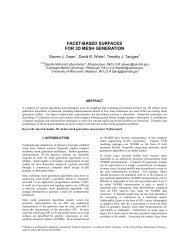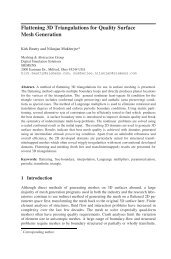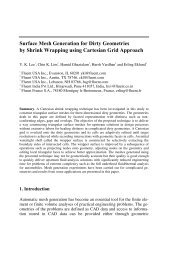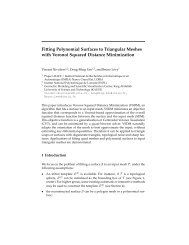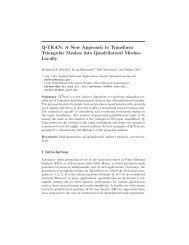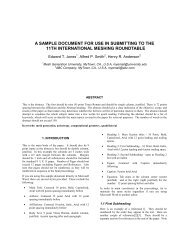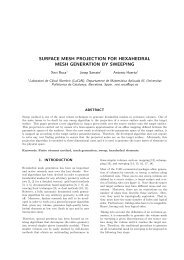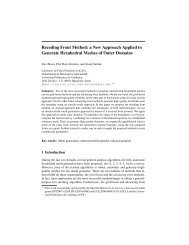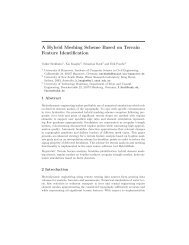CPU-GPU Algorithms for Triangular Surface Mesh Simplification
CPU-GPU Algorithms for Triangular Surface Mesh Simplification
CPU-GPU Algorithms for Triangular Surface Mesh Simplification
Create successful ePaper yourself
Turn your PDF publications into a flip-book with our unique Google optimized e-Paper software.
10 Suzanne M. Shontz and Dragos M. NistorAmount of memory used on the <strong>GPU</strong> (KB)mesh 95-5 90-10 85-15 80-20 75-25 70-30 65-35 60-40 55-45 50-50armadillo 2568 2770 2973 3176 3378 3581 3784 3986 4189 4392bunny 517 558 599 640 680 721 762 803 844 884gargoyle 12813 13824 14836 15847 16859 17871 18882 19894 20905 21917hand 4859 5242 5626 6009 6393 6777 7160 7544 7927 8311horse 228 246 264 282 300 318 336 354 372 390kitten 2035 2196 2356 2517 2678 2838 2999 3160 3320 3481mesh 45-55 40-60 35-65 30-70 25-75 20-80 15-85 10-90 5-95 0-100armadillo 4595 4797 5000 5203 5405 5608 5811 6014 6216 6419bunny 925 966 1007 1048 1089 1129 1170 1211 1252 1293gargoyle 22928 23940 24951 25963 26974 27986 28998 30009 31021 32032hand 8695 9078 9462 9845 10229 10613 10996 11380 11763 12147horse 408 426 444 462 480 498 516 534 552 570kitten 3642 3802 3963 4124 4284 4445 4606 4766 4927 5088Table 3. The amount of memory used, in KB, by the <strong>GPU</strong> during simplification <strong>for</strong>each <strong>CPU</strong>-<strong>GPU</strong> split <strong>for</strong> both the <strong>CPU</strong>-<strong>GPU</strong> naïve algorithm and the <strong>CPU</strong>-<strong>GPU</strong>inverse reduction algorithm.large, the running time decreases as the <strong>GPU</strong> workload increases, whereas ifthe mesh is small, the reverse is true. This can be attributed to the extratime taken to allocate memory in the <strong>GPU</strong> and to copy the data from mainmemory to the <strong>GPU</strong> cache in addition to the time required <strong>for</strong> simplification.We obtain the following metrics after 10 iterations of the algorithm with a<strong>CPU</strong>-<strong>GPU</strong> split of 0-100: numbers of vertices and faces, minimum and maximumelement ages, minimum and average element areas, mesh volume, andthe percentages of vertex and face simplification. The values of the metricscan be seen in Table 4.<strong>Simplification</strong> using the <strong>CPU</strong>-<strong>GPU</strong> naïve marking algorithm does not affectthe mesh volume significantly. It does, however, increase the average areaof each element, which is to be expected. Additionally, the simplification rateis approximately 14% to 15% <strong>for</strong> one iteration of the algorithm.mesh # vertices # faces min ∠ max ∠ min area avg area volumearmadillo 56469 111617 3.091e-2 179.86 3.901e-07 6.077e-1 1.42548e+6bunny 9979 20129 1.477e-1 179.645 6.242e-06 5.759e-2 7.56014e+3gargoyle 278305 629188 3.688e-4 179.981 8.967e-08 1.143e-1 1.64053e+6hand 99635 213061 1.969e-2 179.912 2.674e-09 3.937e-4 1.65117e+1horse 5428 10927 1.874e-2 179.339 1.032e-11 7.162e-6 1.58650e-3kitten 39991 87997 1.530e-2 179.799 2.320e-06 5.259e-1 8.38547e+5Table 4. Metric values <strong>for</strong> the meshes after 10 iterations of the naïve <strong>CPU</strong>-<strong>GPU</strong>marking algorithm.



